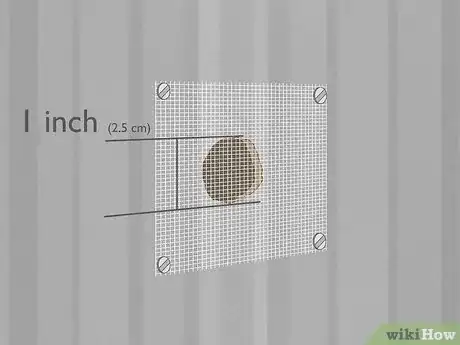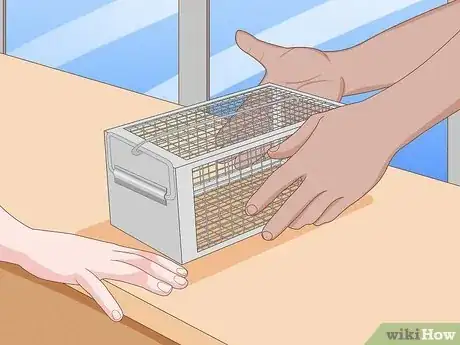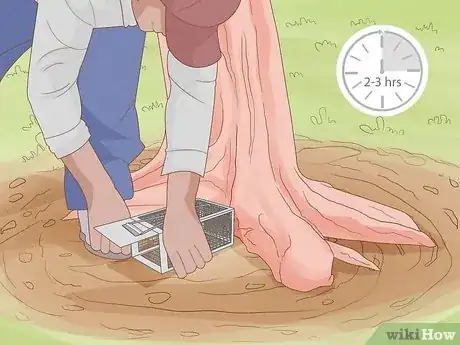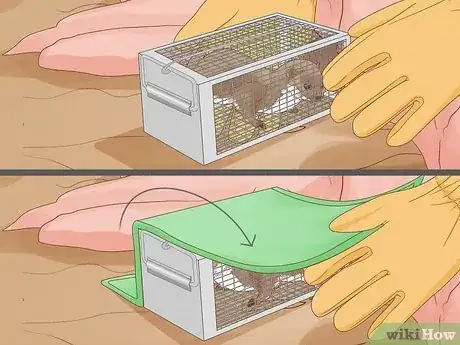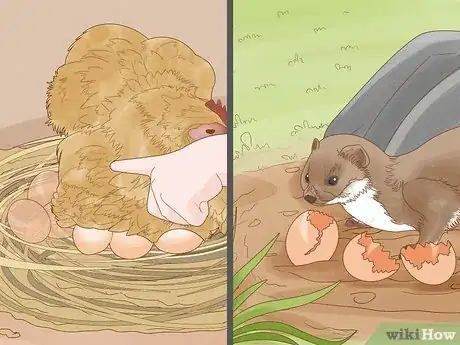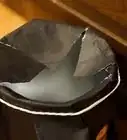This article was co-authored by Elmer Bensinger and by wikiHow staff writer, Kyle Hall. Elmer Bensinger is a Pest Control Specialist with Eden Advanced Pest Technologies in Spokane, Washington. With over 20 years of experience, Elmer specializes in integrated pest management and products such as insecticides and rodenticides. He studied business at South Puget Sound Community College.
There are 12 references cited in this article, which can be found at the bottom of the page.
This article has been viewed 45,569 times.
While weasels are beneficial when they’re preying on rodents that raid your vegetable garden, they can also become a real nuisance if they start attacking your chickens or small pets. The good news is that it’s fairly easy to catch rogue weasels using a store-bought or DIY trap. The key is to use the right bait and set up the trap in a strategic location. Keep reading to learn how to quickly trap these pesky mammals and get them off your property (and away from your animals) for good.
Things You Should Know
- Use an extra-small live trap to easily catch weasels on your property.
- Bait the trap with fresh, raw meat.
- Relocate trapped weasels at least 10 miles (16 km) away from your property.
Steps
Setting a Trap
-
1Contact your local wildlife agency before you do anything. There are sometimes laws that regulate when you’re allowed to trap weasels, and they can vary from state to state. To make sure you're in compliance with these laws and to avoid costly fines, get in touch with the agency before you set a trap.[1]
- If you live in the US, find your local wildlife agency by visiting the US Fish & Wildlife Service website.
-
2Secure your animal pens by closing off any holes. To keep your animals safe, make sure the weasel has no way to enter their cages and pens. This will also limit its access to live prey so it's more likely to enter the trap you set. Nail 1⁄2 in (1.3 cm) wire mesh or hardware cloth across any holes larger than 1 inch (2.5 cm), or cover them with a piece of scrap metal.[2]Advertisement
-
3Get an extra-small live trap (or make your own). A live trap is the most efficient way to catch a weasel without harming it.[3] Look for one with wire or mesh sides.
- You can typically find live traps at your local home improvement store for around $30 USD.
-
4Bait the trap with fresh meat. Weasels are carnivores, so the best way to lure them into a trap is with fresh, raw meat, like liver, fish, or chicken entrails. Place the meat far enough back in the trap that the weasel will have to go all the way into it to get it.[4]
- Buy the meat right before using it so it’s fresh and extra enticing to the weasel.
-
5Place the trap near where the weasel has been active. Nestle the trap somewhere secluded and close to where you suspect the weasel has been hunting.[5] You can usually tell where a weasel has been active by looking for small, five-toed tracks left behind on the ground.[6] You can also set the trap close to any prey the weasel has previously attacked.
- Good places to set a trap are near a chicken coop or pen, inside of a barn, at the base of a tree, or along a stream or creek.
-
6Push back the door mechanism on the trap to set it. The door should click into place when you push it back all the way. When the weasel goes into the trap to get the bait, it will step on a pressure plate that releases a latch, causing the door of the trap to shut.[7]
Relocating the Weasel
-
1Check the trap every few hours. As much of a nuisance as weasels are, you still don’t want to leave one trapped in a cage without food or water for long periods of time. Check the trap frequently, like every 2-3 hours, while it’s set. Avoid going longer than 8 hours without checking it.[8]
- Approach the trap calmly to avoid panicking the weasel. If it panics, it could injure itself on the cage.
-
2Use caution when you’re handling the trap. Weasels can bite, especially when they’re afraid. Keep your hands and fingers away from the weasel when you’re carrying the trap. You may want to wear thick gloves and long sleeves.[9]
- Drape a towel or blanket over the top of the cage before picking it up to help calm down the weasel.[10]
-
3Relocate the weasel at least 10 miles (16 km) from your home. Taking the weasel at least 10 miles (16 km) from your home will help ensure it doesn’t come back.[11] If you live in a rural area, try to take the weasel to a secluded location where it’s less likely to bother someone else’s property and animals.
- Never release a weasel on private property.
- If there’s no ideal location close by where you can release the weasel, call animal control or a wildlife rescue. They’ll come take the animal away for you.[12]
Signs of a Weasel Problem
-
1Prey that’s been bitten on the head or neck. Weasels kill by biting their prey through the skull, upper neck, or jugular vein. This can cause their prey to look as though it’s been nearly decapitated. If you’ve recently lost small animals to an unknown predator and their heads or necks were noticeably injured, you could have a weasel on your property.[13]
-
2Large number of killed animals. Weasels will sometimes kill multiple birds.[14] If you wake up to find that half or more of the chickens in your coop have been attacked, you may very well be dealing with a weasel.
- Weasels have been known to kill entire flocks of chickens at a time, whereas other predators usually only kill what they need for one meal.
-
3Stolen or eaten chicken eggs. If you have chickens, you may notice their eggs being stolen or sucked dry. This could be a sign that a weasel is getting into the coop.[15]
-
4Attacks during winter. Weasels don’t hibernate and are active throughout the entire year. If you lose animals to an attack during the winter, a weasel may be the culprit.[16]
- Other predators, like foxes, are also active during the winter, so this shouldn’t be the only factor you consider when trying to figure out what animal you’re dealing with.
-
5Small footprints with 5 clawed toes. Weasels have 5 toes on both their front and back feet, and claws are usually visible on each toe. However, their tracks can resemble badger, mink, skunk, and otter tracks. If you're not sure, accurately identify the tracks by taking pictures and comparing them to photos of animal tracks online.[17]
Expert Q&A
-
QuestionIs it better to trap or kill a weasel?
 Elmer BensingerElmer Bensinger is a Pest Control Specialist with Eden Advanced Pest Technologies in Spokane, Washington. With over 20 years of experience, Elmer specializes in integrated pest management and products such as insecticides and rodenticides. He studied business at South Puget Sound Community College.
Elmer BensingerElmer Bensinger is a Pest Control Specialist with Eden Advanced Pest Technologies in Spokane, Washington. With over 20 years of experience, Elmer specializes in integrated pest management and products such as insecticides and rodenticides. He studied business at South Puget Sound Community College.
Pest Control Specialist Live traps are more likely to be effective than those snares that kill them.
Live traps are more likely to be effective than those snares that kill them. -
QuestionWhere should I relocate a weasel after I catch it?
 Elmer BensingerElmer Bensinger is a Pest Control Specialist with Eden Advanced Pest Technologies in Spokane, Washington. With over 20 years of experience, Elmer specializes in integrated pest management and products such as insecticides and rodenticides. He studied business at South Puget Sound Community College.
Elmer BensingerElmer Bensinger is a Pest Control Specialist with Eden Advanced Pest Technologies in Spokane, Washington. With over 20 years of experience, Elmer specializes in integrated pest management and products such as insecticides and rodenticides. He studied business at South Puget Sound Community College.
Pest Control Specialist You want to make sure that you take them far away from whatever body of water you found them by. Release them near another body of water so that they'll have somewhere new to live. If you don't release them near water, they may try and find their way back to you!
You want to make sure that you take them far away from whatever body of water you found them by. Release them near another body of water so that they'll have somewhere new to live. If you don't release them near water, they may try and find their way back to you!
References
- ↑ https://icwdm.org/species/carnivores/weasels/weasel-damage-prevention-and-control-methods/
- ↑ https://icwdm.org/species/carnivores/weasels/weasel-damage-prevention-and-control-methods/
- ↑ http://pcwd.info/wp-content/uploads/2016/12/1994Weasels.pdf
- ↑ http://pcwd.info/wp-content/uploads/2016/12/1994Weasels.pdf
- ↑ https://wdfw.wa.gov/species-habitats/living/nuisance-wildlife/trapping
- ↑ http://blog.nwf.org/2014/12/who-goes-there-identifying-animal-tracks-in-your-backyard/
- ↑ http://www.hsi.org/assets/pdfs/eng_ht_set_live_trap.pdf
- ↑ http://www.hsi.org/assets/pdfs/eng_ht_set_live_trap.pdf
- ↑ https://icwdm.org/management/trapping/trapping-safely/
- ↑ http://www.hsi.org/assets/pdfs/eng_ht_set_live_trap.pdf
- ↑ https://www.dnr.state.mn.us/livingwith_wildlife/taking.html
- ↑ https://www.dec.ny.gov/animals/81531.html
- ↑ http://pcwd.info/wp-content/uploads/2016/12/1994Weasels.pdf
- ↑ https://extension.okstate.edu/fact-sheets/protecting-small-poultry-flocks-from-predators.html
- ↑ https://www.discoverwildlife.com/how-to/identify-wildlife/how-to-identify-egg-thieves/
- ↑ https://wildlife-damage-management.extension.org/weasels/
- ↑ http://blog.nwf.org/2014/12/who-goes-there-identifying-animal-tracks-in-your-backyard/
- ↑ https://www.dec.ny.gov/docs/wildlife_pdf/trapbmpsweasel.pdf
- ↑ http://pcwd.info/wp-content/uploads/2016/12/1994Weasels.pdf
About This Article
If you need to trap a weasel, bait an extra-small trap with fresh meat such as fish or chicken entrails. Set the trap in an area with a lot of cover, such as at the base of a tree or in the corner of a barn, and try to get it close to where you think the weasel hunts. Once you have the trap set, check it every 2-3 hours until you catch the weasel. Once you've trapped it, wear heavy gloves and use caution moving the trap, since weasels are known to bite. For tips on identifying a weasel problem, keep reading!

